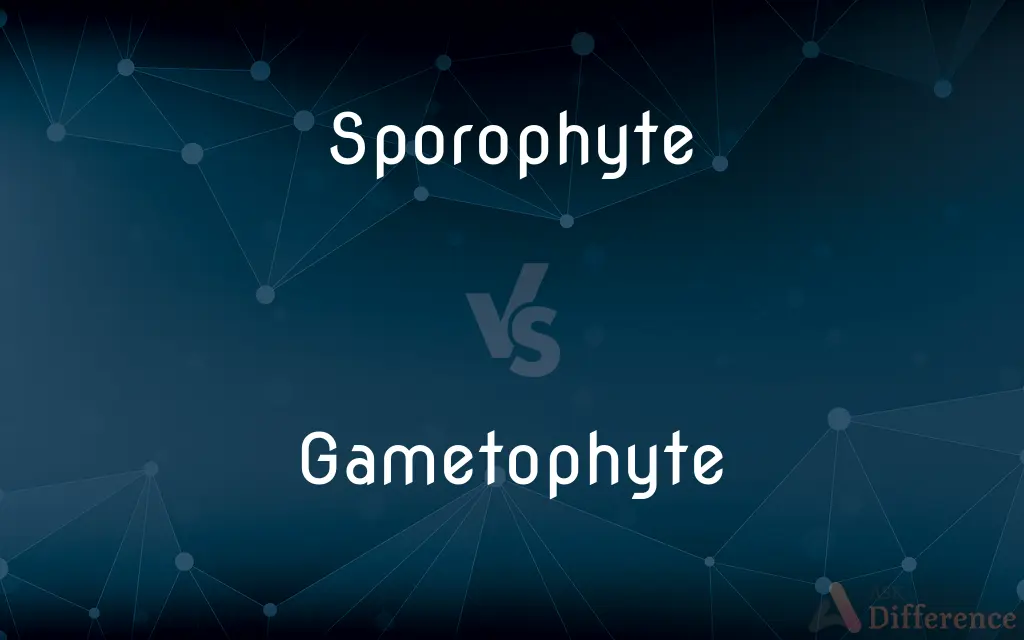Sporophyte vs. Gametophyte — What's the Difference?
Edited by Tayyaba Rehman — By Maham Liaqat — Updated on March 21, 2024
Sporophyte is the diploid phase in the life cycle of plants and algae, producing spores, while gametophyte is the haploid phase, producing gametes.

Difference Between Sporophyte and Gametophyte
Table of Contents
ADVERTISEMENT
Key Differences
The sporophyte phase is characterized by having a diploid chromosome number (2n), meaning each cell contains two sets of chromosomes. In contrast, the gametophyte phase is haploid (n), with cells containing only one set of chromosomes. This difference is fundamental in the alternation of generations observed in plants and some algae.
Sporophytes produce spores through a process called meiosis, where diploid cells undergo division to produce haploid spores. These spores then grow into the gametophyte generation. On the other hand, gametophytes produce gametes (sperm and eggs) through mitosis, where cells divide without changing the chromosome number. When gametes fuse during fertilization, they form a diploid zygote, which grows into a new sporophyte.
In terms of dominance, the sporophyte phase is dominant in most modern plants, including ferns, conifers, and flowering plants, meaning it is the more conspicuous and longer-lived phase of the life cycle. Conversely, in non-vascular plants like mosses, the gametophyte phase is dominant and more visible, while the sporophyte often depends on the gametophyte for nutrition.
The sporophyte structure typically includes the entire plant body in higher plants, such as the familiar green fern or the flowering parts of plants. In contrast, the gametophyte structure may be reduced to just a few cells in some species, like the pollen grains (male gametophyte) and the embryo sac (female gametophyte) in angiosperms.
Both phases are critical for the reproduction of plants, ensuring genetic diversity through the combination of genetic material during fertilization. This alternation between haploid and diploid stages allows for the adaptation and evolution of plant species over time.
ADVERTISEMENT
Comparison Chart
Chromosome Number
Diploid (2n)
Haploid (n)
Produces
Spores through meiosis
Gametes through mitosis
Dominance
Dominant in ferns, conifers, flowering plants
Dominant in non-vascular plants like mosses
Structure
Often the larger, more visible part of the plant
May be reduced to a few cells in higher plants
Role in Life Cycle
Starts with zygote, ends with spore production
Starts with spore germination, ends with gamete production
Compare with Definitions
Sporophyte
Diploid Phase.
The fern's large green fronds are part of its sporophyte phase, showcasing its diploidy.
Gametophyte
Reduced in Higher Plants.
The pollen grain, a male gametophyte, is crucial for plant fertilization.
Sporophyte
Dominant in Higher Plants.
The flowering parts of a plant are sporophyte structures, visible and dominant.
Gametophyte
Haploid Phase.
Moss carpets are primarily gametophyte tissues, showcasing their haploidy.
Sporophyte
Complex Structure.
The entire structure of a typical tree is considered its sporophyte phase.
Gametophyte
Produces Gametes.
In ferns, the small heart-shaped structure on the ground is the gametophyte, producing gametes.
Sporophyte
Produces Spores.
Pine trees release spores from their cones, a sporophyte function.
Gametophyte
Dominant in Mosses.
The visible, green part of moss is the gametophyte, sustaining the smaller sporophyte.
Sporophyte
Generates via Meiosis.
The sporophyte phase undergoes meiosis to produce genetically diverse spores.
Gametophyte
Generates via Mitosis.
Gametophytes use mitosis to produce gametes for plant reproduction.
Sporophyte
A sporophyte () is the diploid multicellular stage in the life cycle of a plant or alga. It develops from the zygote produced when a haploid egg cell is fertilized by a haploid sperm and each sporophyte cell therefore has a double set of chromosomes, one set from each parent.
Gametophyte
A gametophyte () is one of the two alternating multicellular phases in the life cycles of plants and algae. It is a haploid multicellular organism that develops from a haploid spore that has one set of chromosomes.
Sporophyte
The diploid spore-producing phase in the life cycle of a plant that exhibits alternation of generations. It is the dominant stage in vascular plants.
Gametophyte
The haploid gamete-producing phase in a plant characterized by alternation of generations.
Sporophyte
(botany) A plant (or the diploid phase in its life cycle) which produces spores by meiosis in order to produce gametophytes.
Gametophyte
(botany) A plant (or the haploid phase in its life cycle) which produces gametes by mitosis in order to produce a zygote.
Sporophyte
The spore-producing individual or phase in the life cycle of a plant having alternation of generations
Gametophyte
The gamete-producing individual or phase in the life cycle of a plant having alternation of generations
Common Curiosities
Can gametophytes and sporophytes exist independently?
Yes, both can exist independently, but their relationship is interdependent for the completion of the lifecycle.
How do spores differ from gametes?
Spores are haploid cells that can develop into a new organism without fusion, whereas gametes must fuse with another gamete to form a zygote.
What role does meiosis play in the plant life cycle?
Meiosis allows the sporophyte to produce haploid spores, reducing the chromosome number and contributing to genetic diversity.
Why is the sporophyte phase dominant in most plants?
The dominance of the sporophyte phase in most plants reflects evolutionary trends towards more complex life cycles and structures.
How does fertilization occur in plants?
Fertilization occurs when a sperm cell from the male gametophyte fuses with an egg cell from the female gametophyte, forming a diploid zygote.
What is a gametophyte?
A gametophyte is the haploid phase, producing gametes that fuse to form a zygote, which grows into a sporophyte.
What plants have a dominant gametophyte phase?
Non-vascular plants, like mosses, have a dominant gametophyte phase, where it forms the main visible part of the plant.
What is a sporophyte?
A sporophyte is the diploid phase in a plant's lifecycle, producing spores that grow into gametophytes.
How does the alternation of generations benefit plants?
This cycle allows for genetic variation and adaptation, critical for survival and reproduction in changing environments.
Are gametophytes visible to the naked eye?
In some plants, like mosses, gametophytes are visible, but in higher plants, they may be microscopic.
How do environmental factors influence these phases?
Environmental factors can affect the growth, development, and transition between the gametophyte and sporophyte phases.
Is there a genetic difference between sporophytes and gametophytes?
Yes, sporophytes have a diploid genetic makeup, while gametophytes are haploid.
Can the same plant have both gametophyte and sporophyte phases at once?
Yes, the life cycle of plants includes both phases, but they usually occur at different times or as distinct parts of the plant.
What advancements have allowed for the study of these phases?
Advances in genetics, microscopy, and molecular biology have enhanced our understanding of the gametophyte and sporophyte phases.
How do humans use plants in different phases of their life cycle?
Humans utilize plants in both phases for food, medicine, and other products, often without distinguishing between the phases.
Share Your Discovery

Previous Comparison
Sifu vs. Guru
Next Comparison
Sorry vs. ApologyAuthor Spotlight
Written by
Maham LiaqatEdited by
Tayyaba RehmanTayyaba Rehman is a distinguished writer, currently serving as a primary contributor to askdifference.com. As a researcher in semantics and etymology, Tayyaba's passion for the complexity of languages and their distinctions has found a perfect home on the platform. Tayyaba delves into the intricacies of language, distinguishing between commonly confused words and phrases, thereby providing clarity for readers worldwide.















































